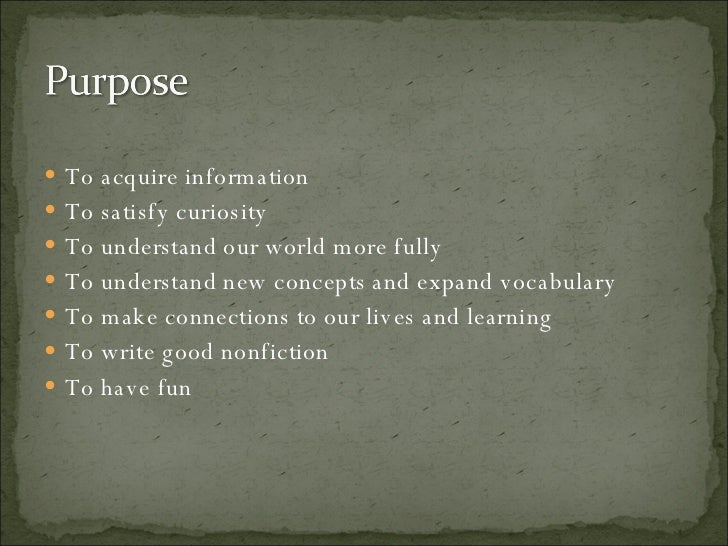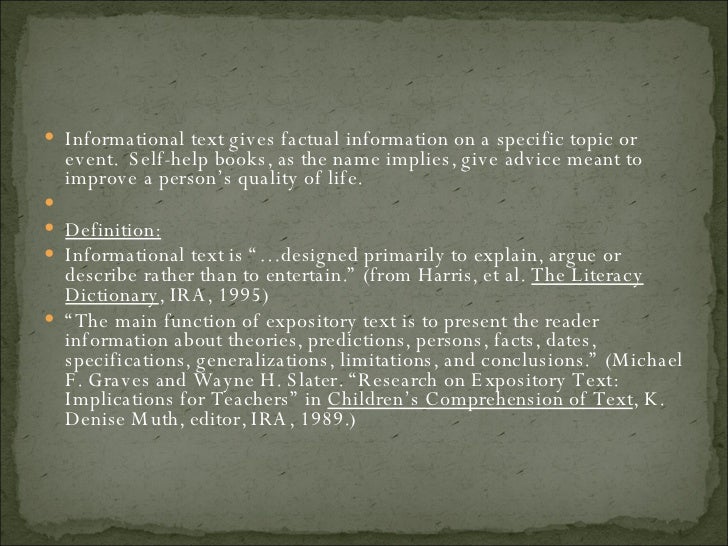



Text Structures in Informational Text
See comments for more information on text structures
Text Features
All the components of a story or article that are not the main body of text. These include the table of contents, index, glossary, headings, bold words, sidebars, pictures and captions, and labeled diagrams. ... The content of a text is what we want students to learn.
Table of Contents
Graphics Key Report |
Lists chapters and their pages; helps the reader to know how the book is organized
Charts, graphs, or figures used to help understand what the author is saying
Something that is crucial for explaining; a list of words or phrases that explains symbols or abbreviations
Describes a subject factually. |
Title/Subtitles
Title Page |
Gives reader a clue as to what the article is about
States title, author, illustrator, publisher
|
Headings
|
Define the chapter's content; direct readers' attention to big ideas
|
Subheadings
|
Break out the important concepts in the chapter; direct reader's attention to big ideas
|
Special Print
|
When a word is bold, italicized, or underlined, the reader should pay attention because it is an important word.
|
Captions
|
Text that explains a picture.
|
Illustrations/Photographs
|
Shows details of what subject looks like.
|
Index
|
Lists subjects alphabetically so the reader can easily find a specific topic or word.
|
Diagram or cut-away
|
Shows detail that might not ordinarily be seen.
|
Labels
|
Helps the reader identify specific parts
|
Glossary
|
Defines key words in text
|
Preface
Maps |
Introduces the book
Shows the location of places in the world |

The vast majority of texts, if not all texts, are written for one or more of these three purposes:
ReplyDelete• To make an argument
• To inform
• To tell a story
To achieve these purposes, authors use one or more of the following 5 text structures:
• Description
• Sequence/Instruction/Process
• Cause/Effect
• Compare/Contrast
• Problem/Solution
Students need to be able to unpack these 5 text structures and understand their components in order to fully understand and analyze the informational text they read, whether they're reading textbooks, news articles, or works of literary nonfiction.
1. Description
ReplyDeleteThis is a pretty straightforward informational text structure — texts that use this structure simply describe something. With few exceptions, these texts also present plenty of details about what they're describing.
Descriptive texts are everywhere — in novels, works of literary nonfiction, news articles, science textbooks — and description is the basis for many informational texts, which makes sense because the entire point of description is to present information.
2. Sequence/Instruction/Process
ReplyDeleteThis text structure covers a few purposes:
• Sequential instructions (Step 1, Step 2, Step 3; Do this, then do that, and finally do this)
• Chronological descriptions of events (This happened, then this happened, etc.)
• Logical arguments
• Arguments that use evidence to support a claim (presenting evidence from least to most convincing)
When students read or write a text with this structure, they need to remember that order is its most important aspect. Texts that use this structure usually don't present any event or instruction out of order — doing so would weaken the text or make its directions more difficult (if not impossible) to follow.
As a ludicrous example, imagine a cake recipe in which preheating the oven was the last step. It wouldn't make sense. It would just be confusing and odd, and you probably wouldn't even try to make sense out of it. Poorly written instructions just aren't worth your time.
Key words to indicate sequence: first, after, finally, before, during, next, last
3. Cause and Effect
ReplyDeleteCause and Effect explains the reasons why an event or something happens. For example, earthquakes, landslides, or volcanic eruptions can trigger or cause a tsunami. Cause and effect also explains the consequences or effects of an event or situation. For example, tsunamis destroy houses and take lives.
Key words: because, cause, led to, reason, effect, result, consequences
4. Compare/Contrast
ReplyDeleteThis text structure examines similarities and differences between two or more things.
Key words: similarly, like, also, in common, while, whereas, but, on the other hand
5. Problem/Solution
ReplyDeleteThis text structure involves two parts:
• The author identifies something he/she considers a problem
• The author details a solution to this problem.
For example, the author might state that pollution is a serious problem and explain why it is a serious problem. Then he might explain how this problem can be alleviated or solved.
"Very insightful! Informational text truly helps in broadening our understanding of various topics. Great explanation!"
ReplyDeleteHeavy duty pallet rack delhi
Pallet storage rack delhi
"I appreciate the breakdown of text features. It’s so important to recognize how these elements enhance learning."
ReplyDeleteSlotted Angle rack delhi
Heavy Duty Warehouse Racking delhi
"The use of different text structures like sequence and cause-effect makes informational texts more engaging. Thanks for explaining this!"
ReplyDeleteIndustrial Pallet Racks Delhi
barrel storage rack delhi
"Self-help books as a form of informational text was an interesting inclusion. Never thought of it that way!"
ReplyDeleteFabric Roll rack india
Pallet storage rack india
"The section on text features like glossaries and sidebars is super helpful for understanding non-fiction texts."
ReplyDeleteSelective Pallet Racking System india
two tier rack India
"I liked how you highlighted the purpose of informational text—acquiring information and satisfying curiosity. Well put!"
ReplyDeleteFabric Roll rack
Heavy Duty Warehouse Racking
"Understanding the organization of informational texts makes it so much easier to analyze and retain information."
ReplyDeleteHeavy duty pallet rack noida
Multi tier rack noida
"I found the explanation of text structures very clear and easy to follow. A great read for educators too!"
ReplyDeleteSelective Pallet Racking Systems noida
two tier rack noida
"The inclusion of labeled diagrams and bold words really makes informational texts stand out. Thanks for pointing this out!"
ReplyDeleteSlotted Angle racks lucknow
Racking system lucknow